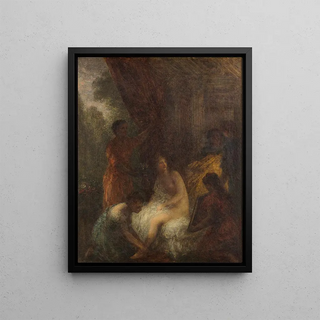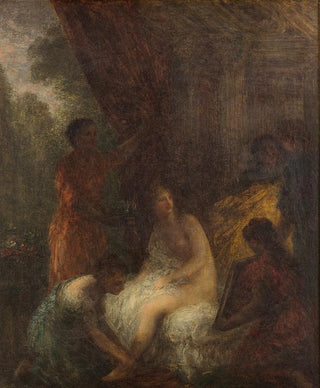Art print | The Toilette - Henri Fantin-Latour


View from behind

Frame (optional)
At the heart of the late 19th century, French art flourished in a richness of styles and movements. Among the emblematic artists of this era, Henri Fantin-Latour stands out for his ability to capture the beauty and intimacy of everyday scenes. His artwork "La Toilette" is part of this tradition, offering a delicate and refined vision of femininity. This piece, imbued with sensitivity, immerses us in a suspended moment where time seems to stand still, allowing us to appreciate the beauty of daily gestures. The harmony of colors and the meticulous attention to detail make this canvas a true ode to feminine softness and grace.
Style and uniqueness of the work
"La Toilette" is characterized by an impressionist style that transcends mere realism to evoke an atmosphere of serenity and intimacy. Delicate brushstrokes, combined with a palette of soft colors, create a warm ambiance that invites contemplation. Fantin-Latour excels in rendering textures, whether it is the soft skin of the models or the luxurious fabrics surrounding them. This artwork does not merely depict a domestic scene; it captures the very essence of femininity, where each gesture becomes an act of beauty. The composition, carefully arranged, guides the viewer’s gaze toward the female figures, while hinting at a blurred external world, symbolizing a life that continues beyond this moment of tranquility.
The artist and his influence
Henri Fantin-Latour, born in 1836, was a painter and lithographer whose work was heavily influenced by the Romantic movement and Impressionism. Although often associated with portraits and still lifes, his exploration of feminine themes demonstrates a particular sensitivity. Fantin-Latour surrounded himself with prominent figures of his time, mingling with artists such as Claude Monet and Édouard Manet, while developing a style that was uniquely his own. His ability to depict everyday life with poetry and depth has left an indelible mark on art history. "La Toilette" is an example

Matte finish

View from behind

Frame (optional)
At the heart of the late 19th century, French art flourished in a richness of styles and movements. Among the emblematic artists of this era, Henri Fantin-Latour stands out for his ability to capture the beauty and intimacy of everyday scenes. His artwork "La Toilette" is part of this tradition, offering a delicate and refined vision of femininity. This piece, imbued with sensitivity, immerses us in a suspended moment where time seems to stand still, allowing us to appreciate the beauty of daily gestures. The harmony of colors and the meticulous attention to detail make this canvas a true ode to feminine softness and grace.
Style and uniqueness of the work
"La Toilette" is characterized by an impressionist style that transcends mere realism to evoke an atmosphere of serenity and intimacy. Delicate brushstrokes, combined with a palette of soft colors, create a warm ambiance that invites contemplation. Fantin-Latour excels in rendering textures, whether it is the soft skin of the models or the luxurious fabrics surrounding them. This artwork does not merely depict a domestic scene; it captures the very essence of femininity, where each gesture becomes an act of beauty. The composition, carefully arranged, guides the viewer’s gaze toward the female figures, while hinting at a blurred external world, symbolizing a life that continues beyond this moment of tranquility.
The artist and his influence
Henri Fantin-Latour, born in 1836, was a painter and lithographer whose work was heavily influenced by the Romantic movement and Impressionism. Although often associated with portraits and still lifes, his exploration of feminine themes demonstrates a particular sensitivity. Fantin-Latour surrounded himself with prominent figures of his time, mingling with artists such as Claude Monet and Édouard Manet, while developing a style that was uniquely his own. His ability to depict everyday life with poetry and depth has left an indelible mark on art history. "La Toilette" is an example






